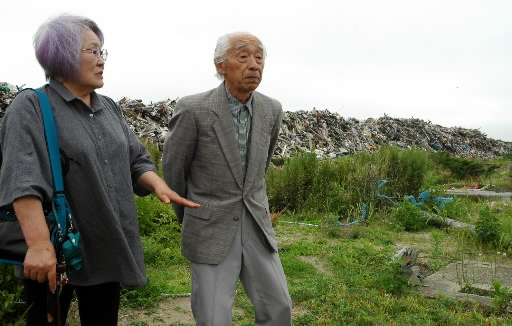Nuclear Reactors Rekindled, Part 1, Article 2
Jul. 1, 2012
Part 1: Through the eyes of A-bomb survivors
Article 2: A-bomb survivors in the disaster zone
by Hiroshi Ebisu, Staff Writer
Mountains of debris remain, reconstruction still far off
Across an area of several hundred meters, debris from the massive tsunami triggered by the Great East Japan Earthquake continues to pile up in heaps about five meters high. The wooden wreckage from homes, household items such as bedding and clothing, fishing gear, and other articles make up the rubble. The mountain of debris attests to the daily lives that were upended by the disaster. The motors of heavy machinery grind through the muddy rubble, emitting a stink that stings the noses of those standing nearby when the direction of the wind changes.
Yoshio Hayashi, 86, was standing at the Ishinomaki Industrial Port in Ishinomaki City, Miyagi Prefecture, which serves as one of the temporary storage sites for the earthquake debris. A resident of Ishinomaki, Mr. Hayashi murmured, “There’s still so much rubble.” Standing by his side was Hisako Kimura, 75, from the city of Sendai. “Reconstruction has a long way to go here,” she said.
Both Mr. Hayashi and Ms. Kimura experienced the atomic bombing of Hiroshima. Ms. Kimura serves as secretary general of the Miyagi Prefectural Atomic Bomb Sufferers Association. Since the earthquake, she has paid regular visits to roughly 180 members of the association to check on their conditions. On this day, too, she was visiting Mr. Hayashi, a former vice president of the group, at his home.
In the port and its vicinity, houses and factories were swept away by the tsunami. Mr. Hayashi’s house is located about five minutes away by car. He says that he avoids looking at the enormous amount of debris placed at the 22 temporary storage sites in the city, explaining, “No one wants to remember the tsunami. Until the debris is removed from the city, we can’t move forward.”
A year and four months have passed since the earthquake. And yet little progress is being made on disposal of the debris. According to the Ministry of the Environment, the total amount of debris that was produced in the prefectures of Iwate, Miyagi, and Fukushima is estimated at 18.8 million tons. But as of the end of June 2012, only 20 percent of this total has been disposed of.
The Japanese government has called for municipalities in Japan to take in the debris from the prefectures of Iwate and Miyagi. But standing in the way of this request are the radioactive substances emitted after the accident at the Fukushima No. 1 (Daiichi) nuclear power plant. Although the government continues to stress the safety of the debris, the fear among local residents who would receive this rubble cannot be easily erased.
This past March, the city council of Hiroshima, the A-bombed city, made the decision to accept the debris. At the same time, in April, the City of Hiroshima did not respond one way or the other when the Japanese government’s request concerning the debris was received. The reason cited: “The City of Hiroshima is not necessarily in a position where it can cast aside fears involving radioactive substances.”
“This is the reality,” said Ms. Kimura, who was exposed to the atomic bombing in Osuga-cho, part of Minami Ward. Over the years, she has undergone eight operations to contend with health struggles. “The A-bomb survivors are more keenly aware of the horror of radiation than anyone,” Ms. Kimura explained. “I couldn’t accept taking in the debris, either, if I lived outside the affected areas. As a resident here, I know it’s too much to ask such a thing.”
On May 5, all 50 of the nuclear power stations in Japan were idle for the first time since the nuclear accident. But this halt to operations at the nation’s nuclear plants lasted only about two months when the No. 3 reactor at the Oi power station, located in Fukui Prefecture, was restarted by the Kansai Electric Power Company. For Mr. Hayashi, restarting the plant makes it seem as if people are already forgetting the nuclear disaster of last year. Despite the fact that the cause of the accident at the plant in Fukushima has not been fully clarified, and there has been a lack of effective action taken with regard to safety measures at the power stations and the disposal of the debris, the resumption of operations at the nation’s nuclear plants has begun.
Mr. Hayashi experienced the atomic bombing while at an army barracks located in Minami Ward. Since his retirement, he has continued to relate his account of the bombing at various places in Miyagi Prefecture, so that “fateful day” won’t be forgotten. “We mustn’t forget the fact that people are still suffering as a result of the nuclear accident,” Mr. Hayashi said, making this appeal from the stricken area where residents continue to live at the mercy of radiation.
(Originally published on July 17, 2012)








